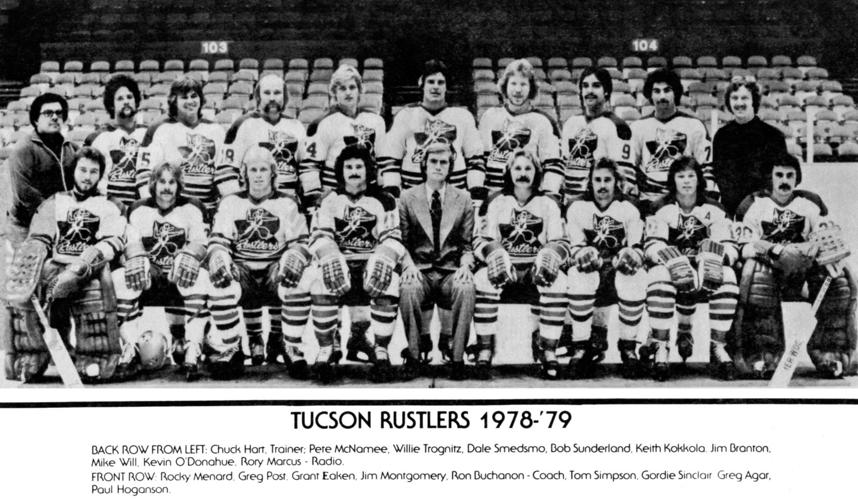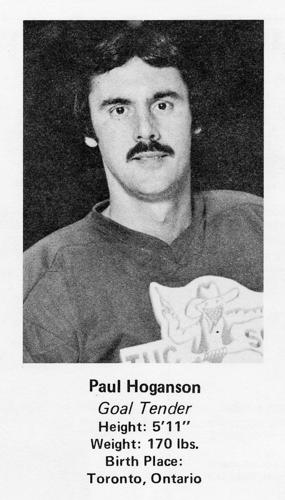The arena and city are the same as in 1975, when Tucson first attempted minor-league hockey, but the time and circumstances now are oh-so-different for the new Tucson Roadrunners.
The 1975-76 Tucson Mavericks were financially viable and should have lasted years, but their type of woes would be repeated by four more attempts at pro-style hockey in the desert.
The most curious entry into Tucson’s hockey derby immediately followed the Mavericks. The 1976-77 Tucson Icemen were fashioned on the long-used Canadian model of teenage amateur juniors, but this time with players of college age (and up). Players were provided room and board and a reported $60-a-month allowance. This hockey was called Senior Amateur, a level common and popular in Canada for decades.
The Southwest Hockey League was also supposed to pay for tuition so players could attend local colleges. The financial viability for a team playing semi-pro hockey in a large and expensive arena made that promise a short-term proposition. This level was developmental, preparing players for the jump up the hockey chain. About half of the Icemen roster did go on to play minor-league pro hockey elsewhere.
The SHL’s money struggles were not only a Tucson problem — the financial model didn’t make sense in any of the six-team league cities, and the circuit as a whole folded with 30 games left in the 1976-77 season.
The Icemen did have the most success on the ice of Tucson’s non-college hockey teams, winning 31 of the 41 games it played. But the team was a major step down from the organization and talent of the previous Central Hockey League pro Mavericks, and its failure most certainly damaged Tucson’s hockey reputation.
The TCC arena was empty for the next season but returned to the pros for 1978-79 with its most talented minor-league team to date. The major-league World Hockey Association once again knocked on Tucson’s door with the Tucson Rustlers. The Rustlers weren’t a minor-league affiliate of a WHA team; rather, the Pacific Hockey League that the Rustlers played in was organized by WHA executives.
By 1978 the massive hockey market expansion of the 1970s was in full contraction and the WHA itself was suddenly half its previous size. Dozens of major-leaguers were suddenly without teams, and the PHL was created in large part to give them places to play. Three of the PHL teams were in cities of recently failed WHA franchises, and they even used their old WHA names and logos, including the — wait for it —Phoenix Roadrunners.
This meant that the talent of the Tucson Rustlers was very good for its level. Frank Hughes was also a proven goal scorer with the former WHA champion Houston Aeros, and Tom “Shotgun” Simpson still had one of the hardest shots in hockey. Teams of the “Slap Shot” era had to have at least one tough guy, and the Rustlers had two: Willie Trognitz and Dale Smedsmo were infamous 1970s hockey roughnecks.
Most famously, Rustlers goaltender Paul Hoganson had previously won the WHA’s longest-ever game, for Indianapolis, in the 1977 playoffs. Hoganson was a true 1970s hockey vagabond, playing in the major-league WHA for Michigan, Baltimore, New England, Cincinnati and Indianapolis, and also with Pittsburgh of the NHL. He saw teams come and go, and he knew almost immediately there was trouble in Tucson.
“The owners took off after about six weeks into the season, and the league operated us for the rest of the year,” he remembers. “Each payday you had to run to the bank to see if your check was gonna cash.”
“Sometimes we practiced in a bowling alley on Speedway (called Iceland), and it was so dark that I was petrified because I couldn’t see the puck. It didn’t even have a full-sized sheet of ice,” he chuckles. “Other times we had to put on our equipment and then bus to Tempe to practice. I still have nightmares about that.”
The Rustlers drew about 1,500 fans a game, Hoganson said, and the fan excitement needed to build a franchise just plain didn’t exist. Still, he could laugh rather than cry during his last pro hockey season.
“We were playing up in Spokane and Willie Trognitz gets thrown out of the game,” Hoganson remembers, “and the announcer said (sarcastically) ‘There goes Wild Willie.’
“Willie goes nuts and grabs about 10 pucks and stands at center ice and starts throwing them at the press box. Both teams had a good laugh at that one.”
Only four of the six PHL teams made it to the end of the season. The playoffs were canceled and the league went kaput. Hoganson settled in Tucson anyway and is excited that a new pro team is finally here.
“I didn’t think they’d ever put another team in Tucson, but now it makes 100 percent sense to me the way they’ve developed the West Coast farm teams,” he said. “This new Roadrunners is a completely different animal than what we’ve had here before. I can’t wait for the season to start.”





